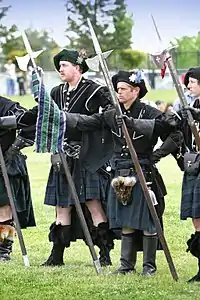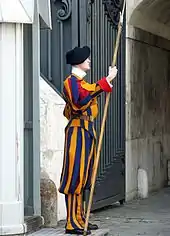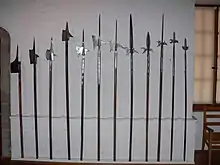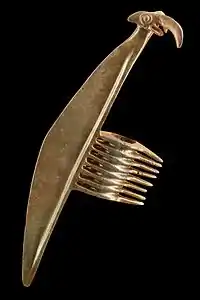Halberd
A halberd (also called halbard, halbert or Swiss voulge) is a two-handed pole weapon that came to prominent use during the 14th, 15th, and 16th centuries. The word halberd is most likely equivalent to the German word Hellebarde, deriving from Middle High German halm (handle) and barte (battleaxe) joint to helmbarte. Troops that used the weapon are called halberdiers.
.jpg.webp)

The halberd consists of an axe blade topped with a spike mounted on a long shaft. It always has a hook or thorn on the back side of the axe blade for grappling mounted combatants.[2] It is very similar to certain forms of the voulge in design and usage. The halberd was usually 1.5 to 1.8 metres (5 to 6 feet) long.[3]
The word has also been used to describe a weapon of the Early Bronze Age in Western Europe. This consisted of a blade mounted on a pole at a right angle.[4][5] The Chinese polearm known as ji is also commonly translated into English as halberd,[6] but they are fundamentally different weapons.[7][8]
History
The halberd was inexpensive to produce and very versatile in battle. As the halberd was eventually refined, its point was more fully developed to allow it to better deal with spears and pikes (and make it able to push back approaching horsemen), as was the hook opposite the axe head, which could be used to pull horsemen to the ground.[9] A Swiss peasant used a halberd to kill Charles the Bold,[10] the Duke of Burgundy, decisively ending the Burgundian Wars in a single stroke.[11] Researchers suspect that a halberd or a bill sliced through the back of King Richard III's skull at the Battle of Bosworth.[12]

The halberd was the primary weapon of the early Swiss armies in the 14th and early 15th centuries.[9] Later, the Swiss added the pike to better repel knightly attacks and roll over enemy infantry formations, with the halberd, hand-and-a-half sword, or the dagger known as the Schweizerdolch used for closer combat. The German Landsknechte, who imitated Swiss warfare methods, also used the pike, supplemented by the halberd—but their side arm of choice was a short sword called the Katzbalger.[13]
As long as pikemen fought other pikemen, the halberd remained a useful supplemental weapon for push of pike, but when their position became more defensive, to protect the slow-loading arquebusiers and matchlock musketeers from sudden attacks by cavalry, the percentage of halberdiers in the pike units steadily decreased. The halberd all but disappeared as a rank-and-file weapon in these formations by the middle of the sixteenth century, though Hakluyt's 'Voyages' relate the death of a halberdier named Zachary Saxy (probably a German) in fighting on the coast of Ecuador during Cavendish's circumnavigation in 1587.
The halberd has been used as a court bodyguard weapon for centuries, and is still the ceremonial weapon of the Swiss Guard in the Vatican[14] and the Alabarderos (Halberdiers) Company[15] of the Spanish Royal Guard.[16] The halberd was one of the polearms sometimes carried by lower-ranking officers in European infantry units in the 16th through 18th centuries. In the British army, sergeants continued to carry halberds until 1793, when they were replaced by spontoons.[17] The 18th century halberd had, however, become simply a symbol of rank with no sharpened edge and insufficient strength to use as a weapon.[18] It served as an instrument for ensuring that infantrymen in ranks stood correctly aligned with each other and that their muskets were aimed at the correct level.[19]
Similar and related polearms
- Bardiche, a type of two-handed battle axe known in the 16th and 17th centuries in Eastern Europe
- Bill, similar to a halberd but with a hooked blade form.
- Ge or dagger-axe, a Chinese weapon in use from the Shang Dynasty (est. 1500 BC) that had a dagger-shaped blade mounted perpendicular to a spearhead
- Fauchard, a curved blade atop a 2 m (6 ft 7 in) pole that was used in Europe between the 11th and 14th centuries
- Guisarme, a medieval bladed weapon on the end of a long pole; later designs implemented a small reverse spike on the back of the blade
- Glaive, a large blade, up to 45 cm (18 in) long, on the end of a 2 m (6 ft 7 in) pole
- Guandao, a Chinese polearm from the 3rd century AD that had a heavy curved blade with a spike at the back
- Ji (戟), a Chinese polearm combining a spear and dagger-axe
- Kamayari, a Japanese spear with blade offshoots.
- Lochaber axe, a Scottish weapon that had a heavy blade attached to a pole in a similar fashion to a voulge
- Naginata, a Japanese weapon that had a 30 cm (12 in) – 60 cm (24 in) long blade attached by a sword guard to a wooden shaft
- Partisan, a large double-bladed spearhead mounted on a long shaft that had protrusions on either side for parrying sword thrusts
- Pollaxe, an axe or hammer mounted on a long shaft—developed in the 14th century to breach the plate armour worn increasingly by European men-at-arms
- Ranseur, a pole weapon consisting of a spear-tip affixed with a cross hilt at its base derived from the earlier spetum
- Spontoon, a 17th-century weapon that consisted of a large blade with two side blades mounted on a long 2 m (6 ft 7 in) pole, considered a more elaborate pike
- Voulge, a crude single-edged blade bound to a wooden shaft
- Tabar, a type of battle axe
- War scythe, an improvised weapon that consisted of a blade from a scythe attached vertically to a shaft
- Welsh hook, similar to a halberd and thought to originate from a forest-bill
- Woldo, A Korean polearm that had a crescent-shaped blade mounted on a long shaft, similar in construction to the Chinese Guandao, and primarily served as a symbol of the Royal Guard
Gallery
 Different sorts of halberds and halberd-like pole weapons in Switzerland
Different sorts of halberds and halberd-like pole weapons in Switzerland Citizens of Zürich on 1 May 1351 are read the Federal Charter as they swear allegiance to representatives of Uri, Schwyz, Unterwalden and Lucerne. One of the representatives carries a typical Swiss halberd of the period depicted (as opposed to the time the image was made, 1515).
Citizens of Zürich on 1 May 1351 are read the Federal Charter as they swear allegiance to representatives of Uri, Schwyz, Unterwalden and Lucerne. One of the representatives carries a typical Swiss halberd of the period depicted (as opposed to the time the image was made, 1515). Saint Wiborada is often (anachronistically) depicted with a halberd to indicate the means of her martyrdom.
Saint Wiborada is often (anachronistically) depicted with a halberd to indicate the means of her martyrdom.
See also
References
- "Théâtre de tous les peuples et nations de la terre avec leurs habits et ornemens divers, tant anciens que modernes, diligemment depeints au naturel par Luc Dheere peintre et sculpteur Gantois[manuscript]". lib.ugent.be. Retrieved 2020-08-25.
- John F. Guilmartin, Jr. "Military technology – Britannica Online Encyclopedia". Britannica.com. Retrieved 2013-06-13.
- "Halberd – Britannica Online Encyclopedia". Britannica.com. Retrieved 2013-06-13.
- The Early Bronze Age Halberd: A History of Research and a Brief Guide to the Sources. Ronan O'Flaherty. The Journal of the Royal Society of Antiquaries of Ireland. Vol. 128 (1998), pp. 74–94. Published by: Royal Society of Antiquaries of Ireland.
- A CONSIDERATION OF THE EARLY BRONZE AGE HALBERD IN IRELAND Function and Context by Ronan O’Flaherty, M.A. A thesis submitted in fulfillment of the requirements for the degree of PhD. UNIVERSITY COLLEGE DUBLIN 2002 Supervisors: Professor Barry Raftery and Dr. Joanna Brück. DEPARTMENT OF ARCHAEOLOGY FACULTY OF ARTS
- Lorge 2011, p. 43.
- "History of Warfare – Land". Historyworld.net. Retrieved 2013-06-13.
- Klaus Schelle, Charles le Téméraire (Arthème Fayard, 1979), p. 316
- Gilbert, Adrian (2003) [2002]. "Medieval Warfare". The Encyclopedia of Warfare: From Earliest Times to the Present Day. Guildford, CT: The Lyons Press. p. 71. ISBN 1-59228-027-7.
At Nancy, it was a halberd that brought down Charles the Bold with a single blow that split his skull open.
- Richard III dig: Grim clues to the death of a king By Greig Watson, BBC News, 4 February 2013
- Ramsey, Syed (2016-05-12). Tools of War: History of Weapons in Medieval Times. Vij Books India Pvt Ltd. ISBN 9789386019813.
- Beam, Christopher (2007-06-06). "What does the Swiss Guard actually do?". Slate.com. Retrieved 2014-03-04.
- Bueno, Jose M. Tropas de la Casa Real. p. 11. ISBN 84-86071-01-1.
- "Inicio". guardiareal.org.
- David Fraser, page 33 "The Grenadier Guards", ISBN 0850452848
- Robin May, page 33 "Wolfe's Army", Osprey Publishing Ltd 1974
- Duffy, Christopher (1998). The Military Experience in the Age of Reason. p. 123. ISBN 1-85326-690-6.
Bibliography
- Brandtherm, Dirk & O'Flaherty, Ronan; Prodigal sons: two 'halberds' in the Hunt Museum, Limerick, from Cuenca, Spain and Beyrǔt, Syria, pp. 56–60, JRSAI Vol.131 (2001). .
- Lorge, Peter A. (2011), Chinese Martial Arts: From Antiquity to the Twenty-First Century, Cambridge: Cambridge University Press, ISBN 978-0-521-87881-4
- O'Flaherty, Ronan; The Early Bronze Age halberd: a history of research and a brief guide to the sources, pp. 74–94, Journal of the Royal Society of Antiquaries of Ireland, Vol.128 (1998).
- R. E. Oakeshott, European weapons and armour: From the Renaissance to the industrial revolution (1980), 44–48.
External links
| Wikimedia Commons has media related to halberds. |
.jpg.webp)